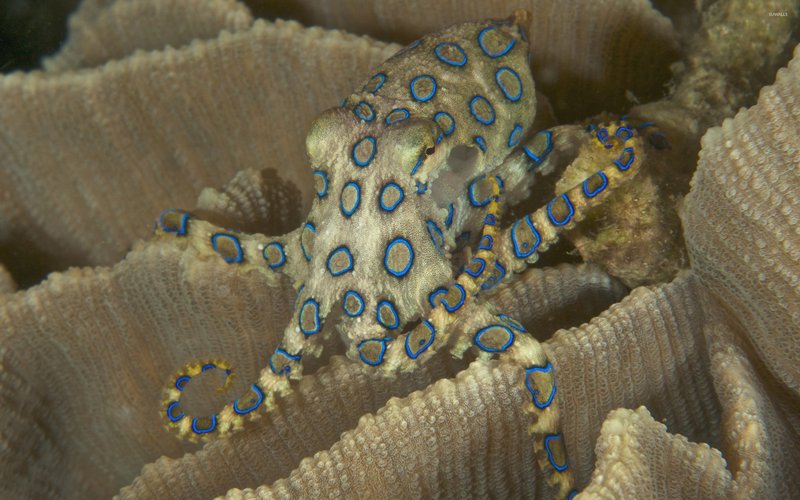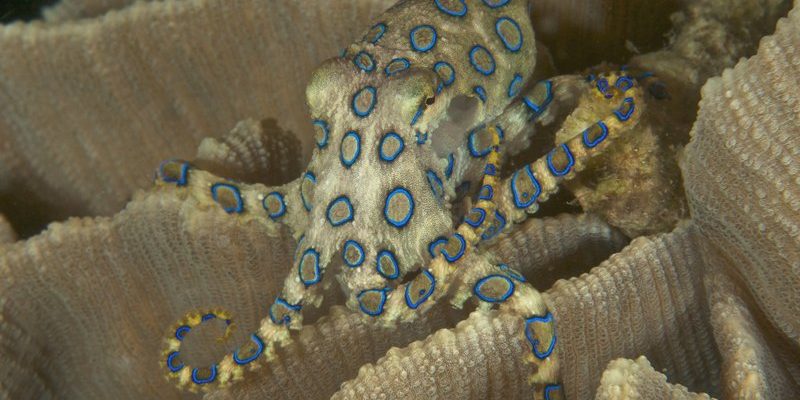
Honestly, the blue-ringed octopus is not just an ordinary marine inhabitant; it’s a creature steeped in folklore and misconceptions. People often confuse reality with myth, leading to misunderstandings about its behavior, venom, and how it fits into the culture of coastal communities. Let’s dive deeper into some of these myths and cultural beliefs, so we can separate fact from fiction and truly appreciate the role of this remarkable creature in our world.
Understanding the Blue-Ringed Octopus
The blue-ringed octopus is one of nature’s most interesting creations. This small cephalopod typically measures about 4 to 5 inches in length but can inflate its body to seem larger when threatened. Its name comes from the vivid blue rings that become more pronounced when it feels threatened. These rings serve as a warning signal to potential predators—think of it as a neon sign flashing, “Stay away!”
What’s fascinating about these octopuses is their venom. Their bite contains a potent neurotoxin called tetrodotoxin, which can be lethal to humans. However, bites are rare because they are generally shy and prefer to remain hidden among reefs or under rocks. Let me explain: while they can be dangerous, they don’t seek out confrontation. If you’re lucky enough to spot one in the wild, just give it space, and you’ll likely be just fine.
Myth 1: Blue-Ringed Octopuses Are Aggressive
One of the biggest misconceptions about the blue-ringed octopus is that it’s aggressive. Many people think these creatures will attack without provocation. Here’s the thing: while they can defend themselves if threatened, they are not inherently aggressive. They prefer to retreat and hide rather than engage in a fight.
In many coastal cultures, stories circulate about encounters with blue-ringed octopuses. Some fishermen might recount tales of being chased by a “vicious” octopus. However, these stories often stem from misunderstandings. Blue-ringed octopuses are shy and typically avoid confrontations unless they feel cornered. If you do encounter one, it’s wise to admire from a distance.
Myth 2: All Blue-Ringed Octopus Bites Are Fatal
Another prevalent myth is that every bite from a blue-ringed octopus is guaranteed to be fatal. This can be a terrifying thought, especially for those who love exploring marine environments. However, the reality is a bit more nuanced.
While their venom is indeed potent and can be life-threatening, fatalities from bites are incredibly rare. Most bites occur when a person tries to handle or provoke the octopus. If bitten, immediate medical attention is crucial, but timely intervention can often result in recovery. It’s essential to respect their space and understand that they’re not out for blood; they just want to live peacefully.
Myth 3: Blue-Ringed Octopuses Are Only Found in Tropical Waters
You might also believe that blue-ringed octopuses inhabit only tropical regions. While many people associate them with warm waters, these fascinating creatures can actually be found in various environments. They thrive in various areas, from the coastal waters of Australia to the shallow reefs of Southeast Asia.
They enjoy rocky habitats and sandy bottoms. This adaptability contributes to their wide distribution. So, whether you’re diving in the Maldives or snorkeling off the coast of Australia, you might find yourself in the presence of a blue-ringed octopus. Just remember, they’re not just limited to tropical locales!
Cultural Beliefs Surrounding the Blue-Ringed Octopus
In many cultures, the blue-ringed octopus carries significant symbolism. For instance, in some Indigenous Australian cultures, the octopus is viewed as a spirit animal. It’s believed that these creatures hold wisdom and a connection to the sea that can teach humans about respect for nature.
In artistic representations, blue-ringed octopuses often symbolize both beauty and danger, illustrating the delicate balance of life in the ocean. You might find them featured in local art, reflecting the duality of their existence: stunning yet potentially perilous. These cultural beliefs emphasize respecting marine environments and understanding our impact on them.
Conservation Efforts and the Future of the Blue-Ringed Octopus
With increasing human activity in marine ecosystems, the blue-ringed octopus faces new threats. Coastal developments, pollution, and climate change are all factors that can impact their habitats. Conservationists are working hard to raise awareness about these incredible creatures and the importance of preserving their environments.
You might be wondering how you can help. Simple actions like reducing plastic use, participating in beach clean-ups, and supporting marine conservation organizations can make a difference. By caring for our oceans, we’re ensuring that future generations can appreciate the beauty and mystery of the blue-ringed octopus.
Wrapping It Up
The blue-ringed octopus is a remarkable creature that captures our imagination and evokes a mix of awe and fear. By debunking myths and exploring the cultural beliefs surrounding these octopuses, we gain a deeper appreciation for their role in our marine ecosystems. Remember, these small animals, while venomous, are not out to harm us; they are simply trying to navigate their own lives in the vast ocean.
By respecting their habitat and promoting conservation efforts, we can ensure the survival of the blue-ringed octopus and continue to marvel at the wonders of the ocean. So, the next time you hear a myth about these incredible creatures, you’ll be ready to share the truth!

